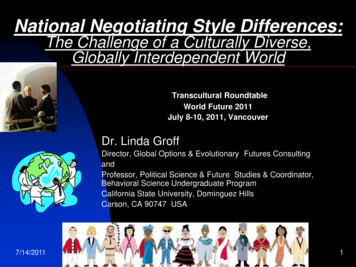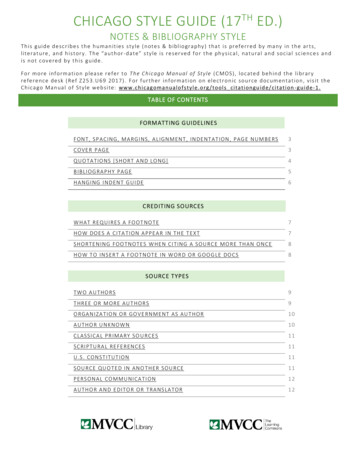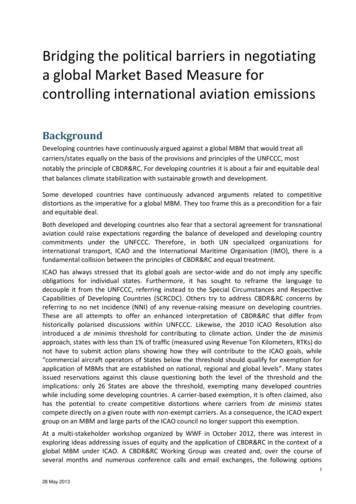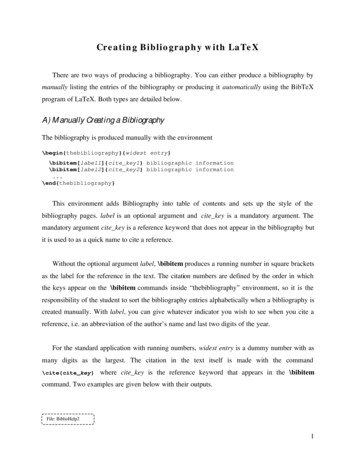
Transcription
National Negotiating Style Differences:The Challenge of a Culturally Diverse,Globally Interdependent WorldTranscultural RoundtableWorld Future 2011July 8-10, 2011, VancouverDr. Linda GroffDirector, Global Options & Evolutionary Futures ConsultingandProfessor, Political Science & Future Studies & Coordinator,Behavioral Science Undergraduate ProgramCalifornia State University, Dominguez HillsCarson, CA 90747 USA7/14/20111
National Negotiating Style Differences:Challenges of a Culturally Diverse,Globally Interdependent WorldTopics to Cover: * * *7/14/2011Theses on Importance of NNS DifferencesDefinitions of Terms: Culture, ICC, NNSTwo Main Theses of ICC Field, & NNSVisible and Invisible Aspects of CultureTwo Archetypal Cultural Paradigms or WorldviewsAdditional Sets of Opposite Values Underlying Behavior in DifferentCultures & Their NNSAdditional Differences in NNS of Different CountriesNNS Characteristics of Different Countries: List of CountriesThree Generalizations re: NNS of Western vs. non-Western countries.NNS of US, Japan, Russia, China, France, Egypt, Mexico, India, &Brazil. Only time to cover a couple today: US & JapanConclusions on NNSPossibility of a Third Cultural Paradigm Emerging TodayRecommended Sources on ICC & NNS2
National Negotiating Style Differences:Challenges of a Culturally Diverse,Globally Interdependent WorldTheses on Importance of NNS Differences:NNS reflect cultures & values underlying different cultures‟ behavior.The challenge of an interdependent world: all the cultures, andtheir different negotiating styles, are interacting with each other.When go to negotiate, two important things:1) the conflict issue to be negotiated;2) the cultural negotiating style of the two parties, which reflectstheir cultural values, & gets superimposed on the conflict issue„IF‟ don‟t understand culture & negotiating style of other partner,can offend them, & undermine chance of an agreement on theissue.7/14/20113
National Negotiating Style Differences:Challenges of a Culturally Diverse,Globally Interdependent WorldDefinitions of Terms:Culture: broad definition; all of our socially-learnedbehaviorSocialization: how we learn our culture—through manyinstitutions and agents of socialization in different areas.Intercultural Communication (ICC): what happens whenpeople from different cultures come together to interact,communicate, & negotiate with each other.National Negotiating Styles (NNS): a subarea of ICC;how underlying values effect cultural behavior & NNS.7/14/20114
National Negotiating Style Differences:Challenges of a Culturally Diverse,Globally Interdependent WorldTwo Main Theses of ICC Field, & NNS:* The message sent is often not the message received—especially when people don‟t know each other‟s cultures.* DIE: Description, Interpretation, Evaluation or Judgment of theBehavior of Someone from Another Culture. Problem comeswhen people from two cultures interpret the same behavior orwords in different ways, because they don‟t know the otherculture, & thus interpret the other culture‟s behavior based on itsmeaning in their own culture instead, which can then lead to anegative judgment of the other party.7/14/20115
National Negotiating Style Differences:Challenges of a Culturally Diverse,Globally Interdependent WorldVisible and Invisible Aspects of Culture:7/14/20116
National Negotiating Style Differences:Challenges of a Culturally Diverse,Globally Interdependent WorldTwo Archetypal Cultural Paradigmsor Worldviews—Based onAssumptions about:* Relationships with Others* Relationships with Nature* Relationship with God/Spirit(see next slide)7/14/20117
Two OppositeArchetypal CulturalParadigms orWorldviews—re:Relations withOthers, Nature, &God/Spirit:1) Segmented: All isSeparate2) Homogenized Unity:All is One7/14/2011AREAIDENTITYSEGM ENTED THINKING INTERDEPENDENTWORLD VIEWTHINKING &WORLDVIEWIndividual Identity—AsCollective Identity—AsSeparate IndividualsMembers of a Group,i.e.,in Relationship to OthersSOCIETYSeparate IndividualsHomogenized UnityNATURESeparate from Nature,thus Try to Control NaturePart of Nature,thus Livein Harmony with NatureGOD/SPIRITGod is Transcendent andSeparate from HumansSpirit is Indwelling inNature & in All Things-Minerals, Plants,Animals, & HumansSCIENCEDivide Reality Up IntoSeparate Parts andAnalyze Each SeparatelyReality is anInterdependent Whole;Seek to BalanceDifferent Parts Relativeto Each OtherM EDICINEBody Made Up ofSeparate Parts; Take OutDefective Parts ThroughSurgery, Etc.Body is an Energy FlowSystem--Ki. Goal is toKeep Energy in DifferentParts of Body in Balance.CONFLICTRESOLUTIONAdversarial, Win-LoseApproach (Win for OwnSide);Example:LitigationSeek Harmony and WinWin Outcomes.Example: Mediation.CULTURELow Context: Goal &Results-Oriented (MalePrinciple); More WesternCulturesHigh Context: Process &Relationship-Oriented(Female Principle); MoreEastern/Non-WesternCultures.8
National Negotiating Style Differences:Additional Sets of Opposite Values UnderlyingBehavior in Different Cultures & Their NNS:*******High Context Cultures vs. Low Context CulturesCollective Identity vs. Individual Identity CulturesIndirect vs. Direct Communication CulturesNonverbal vs. Verbal Communication CulturesNeutral Cultures vs. Affective CulturesParticularist Cultures vs. Universalist CulturesDiffuse Cultures vs. Specific CulturesNote: If know even the first three value characteristics of aculture, will know a lot about their NNS.7/14/20119
National Negotiating Style Differences:Additional Sets of Opposite Values UnderlyingBehavior in Different Cultures & Their NNS:(continued-2)* Ascribed Status vs. Achieved Status Cultures* Being Cultures (Inner Mastery/Peace) vs. Doing Cultures(Outer Mastery & Action in the World)* External LOC (Living in Harmony with Cycles of Nature)vs. Internal LOC/Motivation (Seeking to Control Nature forOwn Human Ends)* Synchronic Time vs. Linear Time Cultures* Space (More vs. Less) Between People When Talking7/14/201110
National Negotiating Style Differences:Additional Differences in Negotiating Styles ofDifferent Countries:* Concrete Thinking Cultures (Japan, China) vs. AbstractThinking Cultures (Russia) vs. Both (US: many Nobel Prizewinners in science, plus practical, “can do” culture).* Hierarchical /Dominant vs. Horizontal/Egalitarian Cultures* Autocratic/Dictatorial Cultures vs. Democratic Cultures:* Negotiators must report to Leader vs. Negotiators givenmore freedom to suggest new ideas in negotiation.* Compromise Good (USA) vs. a Sign of Weakness (Russia)* Agreement a Legal Doc/Final (US) vs. Open-Ended (China)* Negotiators Seek Detailed Agreements (covering all contingencies-USA) vs. General Agreements (Japan, Others)7/14/201111
National Negotiating Style Differences:Challenges of a Culturally Diverse,Globally Interdependent WorldNational Negotiating Styles ofDifferent Countries: Brazil12
National Negotiating Style Differences:Challenges of a Culturally Diverse,Globally Interdependent WorldNational Negotiating Styles of DifferentCountries: Three Generalizations:* In general, Western countries are more low context, andnon-Western countries more high context cultures.* In general, Western countries have more individual identity,and non-Western cultures more collective identity.* In general, Western countries have more directcommunication styles, and non-Western countries moreindirect communication styles.7/14/201113
National Negotiating Style Differences:Challenges of a Culturally Diverse,Globally Interdependent WorldU.S. Negotiating Style Characteristics:7/14/201114
Key Symbols of US Culture:7/14/201115
National Negotiating Style Differences:Challenges of a Culturally Diverse,Globally Interdependent WorldJapanese Negotiating Style Characteristics:7/14/201116
Key Symbols of Japanese Culture:7/14/201117
National Negotiating Style Differences:Challenges of a Culturally Diverse,Globally Interdependent WorldRussian Negotiating Style Characteristics:7/14/201118
Key Symbols of Russian(& former Soviet) Culture:7/14/201119
National Negotiating Style Differences:Challenges of a Culturally Diverse,Globally Interdependent WorldChinese Negotiating Style Characteristics:7/14/201120
Key Symbols of Chinese Culture:7/14/201121
National Negotiating Style Differences:Challenges of a Culturally Diverse,Globally Interdependent WorldFrench Negotiating Style Characteristics:7/14/201122
Key Symbols of French Culture:7/14/201123
National Negotiating Style Differences:Challenges of a Culturally Diverse,Globally Interdependent WorldEgyptian Negotiating Style Characteristics:7/14/201124
Key Symbols of Egyptian Culture:7/14/201125
National Negotiating Style Differences:Challenges of a Culturally Diverse,Globally Interdependent WorldMexican Negotiating Style Characteristics:7/14/201126
Key Symbols of Mexican Culture:7/14/201127
National Negotiating Style Differences:Challenges of a Culturally Diverse,Globally Interdependent WorldIndian Negotiating Style Characteristics:7/14/201128
Key Symbols of Indian Culture:7/14/201129
National Negotiating Style Differences:Challenges of a Culturally Diverse,Globally Interdependent WorldBrazilian Negotiating Style Characteristics:7/14/201130
Key Symbols of Brazilian Culture:7/14/201131
National Negotiating Style Differences:Challenges of a Culturally Diverse,Globally Interdependent WorldConclusions on National Negotiating Styles:National Negotiating Styles reflect a country‟s cultural behavior &the values underlying that behavior.Before going to another culture, do your homework and learn basiccharacteristics of their culture & negotiating style, so not surprisedwhen their behavior is different from yours.Once in another culture:* Watch behaviors of respected leaders as models to follow.* Find a local mentor or teacher to consult about proper behavior.* Realize everyone is different—even in group cultures. Get toknow each person to see how much they reflect their culture or not.7/14/201132
National Negotiating Style Differences:Challenges of a Culturally Diverse,Globally Interdependent WorldConclusions on National Negotiating Styles:* Cultures are also dynamic and changing, not static—especially aspeople from different cultures are increasing interacting globally.* Thus NNS are also evolving.* Identities of many people are becoming more complex andinfluenced by the different cultures they have interacted with.* The ICC Field also recommends that people learn “styleswitching,” i.e., adapt in one‟s negotiating style to the otherculture one is negotiating with.* This doesn‟t mean you lose your own culture.* Ideally both sides should go half way to adapt to each other‟sNNS. Example: A Westerner & a Japanese: can both shakehands & bow exchange business cards/meishi when meeting.7/14/201133
Possibility Today ofa Third CulturalParadigmWorldviewEmerging—as AllCultures Interact:1) Homogenized Unity: Allis One.2) Segmented: All isSeparate.3) Complex Systems: BasedITEMPOLE ONECultures.7/14/2011( not eith e r/ or)Both G roup AN DIndivi dual Need sand Ide ntityImp ortant(M aslow ’ sSyner gisticSoci e tyBothRelation ship s AN DA chievement sImpo rtantMean s AND End sBoth Im portant( Gandhi: “Themean s are a simport a nt as theend s.” )Both Spiri t ualAN D MaterialV alue s Import antBothRelation ship s/Pr oce ss AN DGoal s/ Achievement s Imp ortantCulturalIdentityGroup/Collective IdentityMale - FemalePri nciple sFemale Principle: Identit ythr ough RelationshipsMean s/End sMeans More Important(more Eastern Cultures)Spiri t ual/ Material V alue sSpiritual/Unseen ValuesMost Imp ortantHigh- LowContextCulture sHigh Context Cultures:More Pr ocess-Oriented.Must develop relation ships and get to knowpeople (dev elop trust)before can do businessCulture &Thinkin gConcrete Thinking MorePrevalent: conversationtends to the con crete.Concr e te AN DAbs tract Thinkin gPreva le ntReli gionImma nent SpiritualityReli gionFemale Images of Divinity:Nature Spirits, MotherNature/Goddess, and/orGoddessesBoth Imman e ntAN DTran sce ndentForm s ofSpiri t ualityMale AND FemaleIma ge s ofDivinity: God s &Godde sse s asA ttri bute s of theOne God or Sp irit( w hich tr a nscend sall duality )on BOTH Interdependence/Unity AND Diversity ofBOTH/ANDPOLE TWOIndivi dual Ide ntityMale Principle:Identity t hrou ghA chievement sEnd s More Imp orta nt( more We sternCulture s)Material/SeenV alue sMost Impo rtantLow Co ntextCulture s: MoreGoal/ A chievementOriente d. Can dobusine ss w ithanyone (b ecau sehave p rote ction ofthe law )Abs tract Thinkin gMore Pr e valent:co nver sati on tend sto the a bs tra ct.Tran sce ndent GodMale Ima ges ofDivinity: One G od(M al e)34
National Negotiating Style Differences:Challenges of a Culturally Diverse,Globally Interdependent WorldWhat Future Will We Create-For Humanity and the World?The Future isIn Our Hands7/14/201135
National Negotiating Style Differences:Suggested Sources on ICC & NNS:* Hans Binnendijk, National Negotiating Styles (first U.S. StateDept., Center for Study of Foreign Affairs, study on NNS of sixcountries—France, Japan, Russia, China, Egypt, & Mexico).* John McDonald, “An American‟s View of a U.S. NegotiatingStyle,” in International Negotiation (1996)* Craig Storti, Figuring Foreigners Out. Workbook.* Fons Trompenaars & Chas. Hampton-Turner, Riding the Wavesof Culture. Has data from surveys in many countries.* Film Series, Going International, by Copeland & Griggs.* Society for Intercultural Education, Training, & Research.* Summer Institutes in ICC. * Intercultural Press* Culturegrams—on most countries of the world.* Many books/articles on culture & NNS of different countries.7/14/201136
National Negotiating Style Differences:Challenges of a Culturally Diverse,Globally Interdependent WorldArticles available from Linda Groff on “The Dialogueof Cultures, Civilizations, & Religions,” & relatedtopics.Future article by Linda Groff on: “NationalNegotiating Styles: Challenges of a CulturallyDiverse, Globally Interdependent World.”** Leave card if interested.7/14/201137
National Negotiating Style Differences:Challenges of a Culturally Diverse,Globally Interdependent WorldThanks To:Pony Vigil--For Help Designing an Earlier Versionof This PowerPoint Presentation7/14/201138
National Negotiating Style Differences:The Challenge of a Culturally Diverse,Globally Interdependent World"Our generation has arrived at the threshold of a new era in human history:the birth of a global community. Modern communications, trade andinternational relations, as well as the security and environmental dilemmas weall face, make us increasingly interdependent. No one can live in isolation.Thus, whether we like it or not, our vast and diverse human family must finallylearn to live together. Individually and collectively we must assume a greatersense of Universal Responsibility.”--The XIVth DalaiLama7/14/201139
Globally Interdependent World Conclusions on National Negotiating Styles: * Cultures are also dynamic and changing, not static—especially as people from different cultures are increasing interacting globally. * Thus NNS are also evolving.










